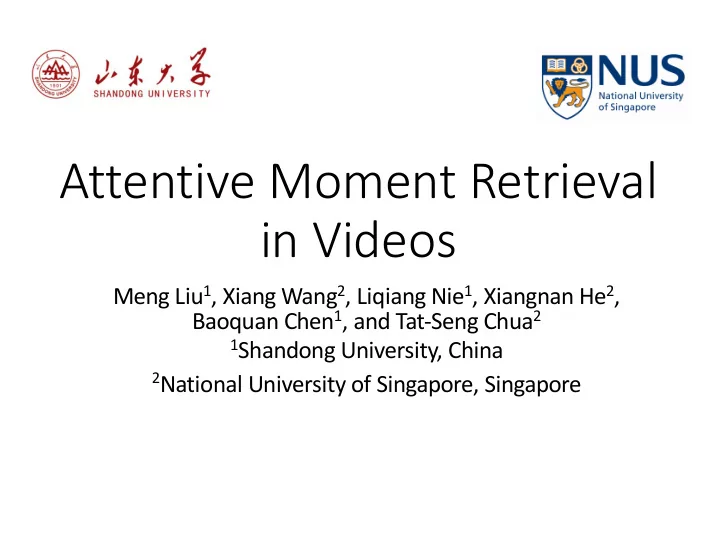

Attentive Moment Retrieval in Videos Meng Liu 1 , Xiang Wang 2 , Liqiang Nie 1 , Xiangnan He 2 , Baoquan Chen 1 , and Tat-Seng Chua 2 1 Shandong University, China 2 National University of Singapore, Singapore
Pipeline • Background • Learning Model • Experiment • Conclusion
Pipeline • Background • Learning Model • Experiment • Conclusion
Background • Inter-video Retrieval Query: FIFA World Cup … … Query: Pig Peggy … …
Background • Intra-video Retrieval Retrieving a segment from the untrimmed videos, which contain complex scenes and involve a large number of objects, attributes, actions, and interactions. Messi's penalty/Football shot
Background • Surveillance Videos: Finding missing children or pets and suspects Query: A girl in orange first walks by the camera. • Home videos: Recalling the desired moment Query: Baby’s face gets very close to the camera. • Online Videos: Quickly Jumping to the specific moment
Background Reality: Dragging progress bar to locate the desired moment. Boring and time consuming Research: Densely segment the long video into different scale moments, and then match each moment with the query. Expensive computational costs and the exponential search space
Problem Formulation -Temporal Moment Localization Input: a video and a language query Query: a girl in orange walks by the camera. 24s 30s Output: Temporal moment corresponding to the given query (green box) with time points [24s,30,s]
Pipeline • Background • Learning Model • Experiment • Conclusion
Learning Model-Pipeline Video Query Girl with blue shirt drives past on bike. Memory Attention Moment Feature Query Feature Network Cross-Modal Fusion Alignment Score Localization Offset MLP Model 0.9 [1.2s, 2.5s]
Learning Model-Feature Extraction • Video 1. Segmentation: segment video into moments with sliding window, each moment ! has a time location [# $ ,# & ] 2. Computing location offset: [ ( $ ,( & ]= [) $ ,) & ] - [# $ ,# & ] , [) $ ,) & ] is the temporal interval of the given query 3. Computing temporal-spatio feature * + : C3D feature for each moment • Query , : Skip-thoughts feature
Learning Model-Moment Attention Network • There are many temporal constraint words in the given query, such as the term “first”, “second”, and “closer to”, therefore temporal context are useful to the localization. • Not all the context have the same influence on the localization, the near context are more important than the far ones.
Learning Model-Memory Attention Network Memory cell , $ # $ < + ) $ ) > ? 8(' 5 6 , , 7 = 8(+ ' @ 7 + ) @ ) :;/0 1 5(6 , , 7) 4 $ % = , C ∈ [−E $ , E $ ] 0 1 ∑ B;/0 1 5(6 B , 7) # $ % = ' " $ # $ % + ) $ ! * $ = + 4 $ % " # $ % ,∈[/0 1 ,0 1 ]
Learning Model- Cross-modal Fusion The output of this fusion procedure explores the intra- modal and the inter-modal feature interactions to generate the moment-query representations. ) ⋮ ⋮ " ) Query ( ! Mean Mean Moment ( ⋮ ⋮ pooling pooling ⨂ ⋮ ⋮ 1 1 ⋮ ⋮ ⋯ ⋯ ⋯ ⋯ 1 "# = % & " ⨂ ) * ! 1 = [ % & " , % & " ⨂) *, ) *, 1] Intra Query Intra Visual Inter Modal 1
Learning Model- Loss Function Given the output of the fusion model into a two Layer MLP model, and the output of the MLP model is a three dimension vector ! " = [% &' ,) * ,) + ] . - = - ./012 + 4- /5& - ./012 = 6 7 8 (&,')∈< log 1 + exp −% &' + 6 E 8 (&,')∈F log 1 + exp % &' ∗ − ) * + G() + ∗ − ) + )] - /5& = 8 [G ) * (&,')∈<
Pipeline • Background • Learning Model • Experiment • Conclusion
Experiment - Dataset • TACoS and DiDeMo • Evaluation: R(n,m)=“R@n,IoU=m”
Experiment – Performance Comparison
Experiment – Model Variants • ACRN-a (pink): Mean pooling context feature as moment feature • ACRN-m (purple): Attention model without memory part • ACRN-c (blue): Concatenating multi-modal features
Experiment – Qualitative Result
Pipeline • Background • Learning Model • Experiment • Conclusion
Conclusion • We present a novel Attentive Cross-Modal Retrieval Network, which jointly characterizes the attentive contextual visual feature and the cross-modal feature representation. • We introduce a temporal memory attention network to memorize the contextual information for each moment, and treat the natural language query as the input of an attention network to adaptively assign weights to the memory representation. • We perform extensive experiments on two benchmark datasets to demonstrate the performance improvement.
Thank you Q&A
Recommend
More recommend